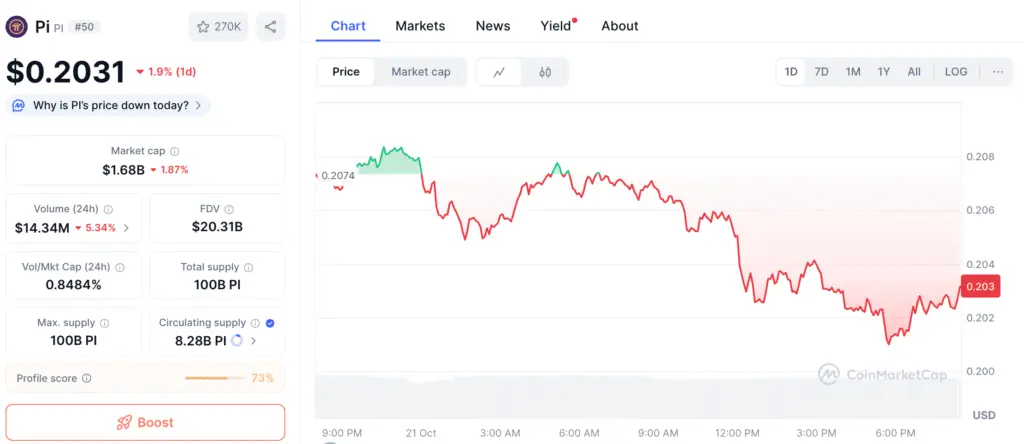Pi Network Faces Historic Price Drop After Major Update
The price of Pi Network has plunged to an all-time low following the rollout of its highly anticipated App Studio upgrade. The update, expected to be a transformative step for the project, aimed to attract developers and boost decentralized app creation. Instead, it triggered a sharp market sell-off that has shaken investor confidence in Pi’s long-term sustainability.
This reaction highlights the widening gap between Pi Network’s ambitious technological goals and the market’s expectations. Despite years of hype and a massive mining community, the token’s economic structure continues to struggle with maintaining price stability. This raises critical questions about whether Pi can transition from a social mining experiment into a functioning digital economy.

Major Update Aims to Strengthen Real-World Utility
The App Studio update marked a major milestone intended to onboard third-party developers and increase real-world utility for Pi. The platform now allows the creation of decentralized applications (dApps) that operate within the Pi ecosystem. In theory, this should expand token circulation and drive organic demand.
However, the rollout led to an immediate negative reaction. Traders viewed the event as a “sell-the-news” moment, underscoring lingering doubts about Pi Network’s ability to deliver tangible outcomes. The absence of clear adoption metrics and limited institutional participation further weakened market confidence.
Pi Network Faces Selling Pressure Amid Oversupply From Free Mining
Pi’s tokenomics remain a major challenge. The token faces ongoing selling pressure due to its massive circulating supply generated by years of free mobile mining. Exchange data reveals increased outflows, suggesting that many users are offloading their holdings amid declining confidence.
Unlike deflationary assets such as BNB or Ethereum, Pi’s inflationary model and lack of strong burn mechanisms make sustained price growth difficult. Without meaningful structural reform or new external capital, the imbalance between supply and demand will likely persist.
Recommended Article: Pi Network Chart Shows Bullish W-Pattern and $0.23 Breakout
Weak Market Support and Falling Liquidity
From a technical perspective, Pi Network has failed to establish reliable support zones. Attempts at recovery have been consistently rejected, indicating weak liquidity and diminishing trading volumes. The inability to maintain stability above the $0.20 psychological barrier highlights fragile market sentiment.
Moreover, the limited number of exchange listings and trading pairs restricts accessibility for new investors. This isolation exacerbates volatility, amplifying downward price movements during sell-offs.
Pi Faces Ecosystem Stagnation Amid Lack of Cross-Chain Integration
Although App Studio introduces valuable tools for developers, experienced blockchain builders remain hesitant to engage. Competing ecosystems like Ethereum, Solana, and BNB Chain offer better liquidity, stronger financial incentives, and larger user communities. As a result, Pi’s ecosystem expansion has lagged, despite boasting one of the largest mining populations in crypto.
Experts argue that Pi Network must shift its focus from internal improvements to external collaborations that drive interoperability and adoption. Without cross-chain functionality or real-world use cases, developer enthusiasm will likely remain limited.
Investor Sentiment Shows Ongoing Distrust
Market sentiment surrounding Pi Network has turned increasingly pessimistic. Many long-time miners who once supported the vision now express frustration over delays in launching the mainnet and the lack of transparent communication. While community enthusiasm persists, developer execution continues to fall short.
Social media discussions reflect growing disappointment that Pi’s major updates have failed to produce measurable economic outcomes. Analysts note that waning trust in the Pi Core Team’s roadmap has further fueled bearish sentiment, raising the risk of additional price declines.
Pi Network Must Prove Real Utility to Regain Investor Confidence
Despite the current downturn, Pi Network still has an opportunity to recover if it can demonstrate genuine real-world utility. To rebuild credibility, upcoming development phases must prioritize practical use cases such as merchant integrations, DeFi applications, and payment infrastructure.
Ultimately, Pi’s sustainability depends on evolving from a community-driven mining experiment into a functional digital economy. Until that transformation occurs, prices are likely to remain under pressure—illustrating that in today’s crypto landscape, innovation without adoption carries little lasting value.















